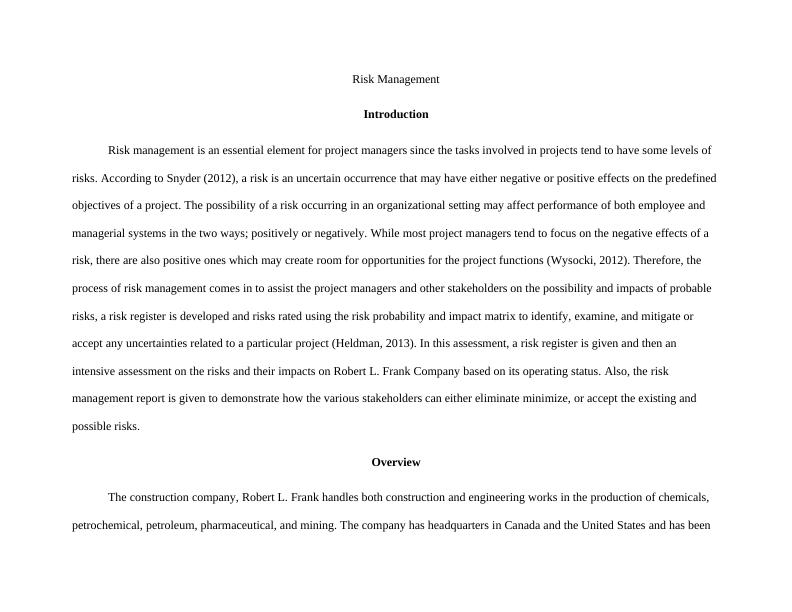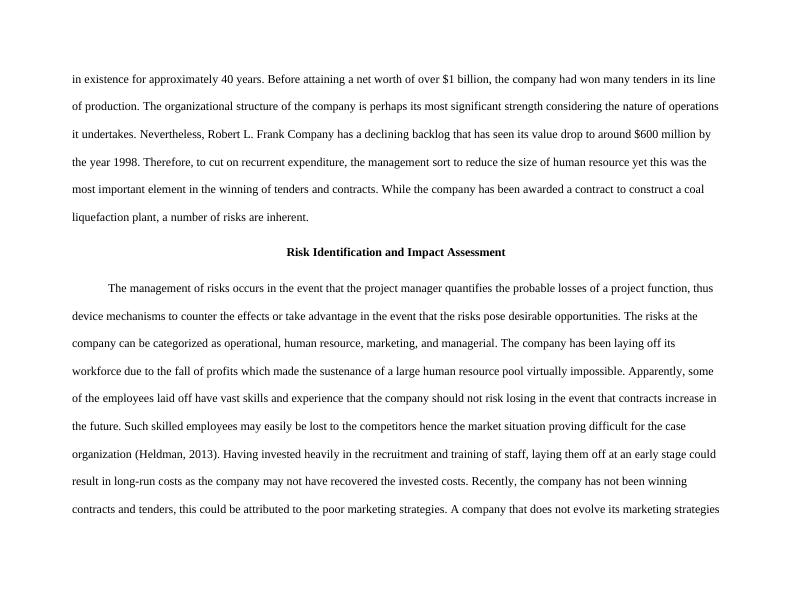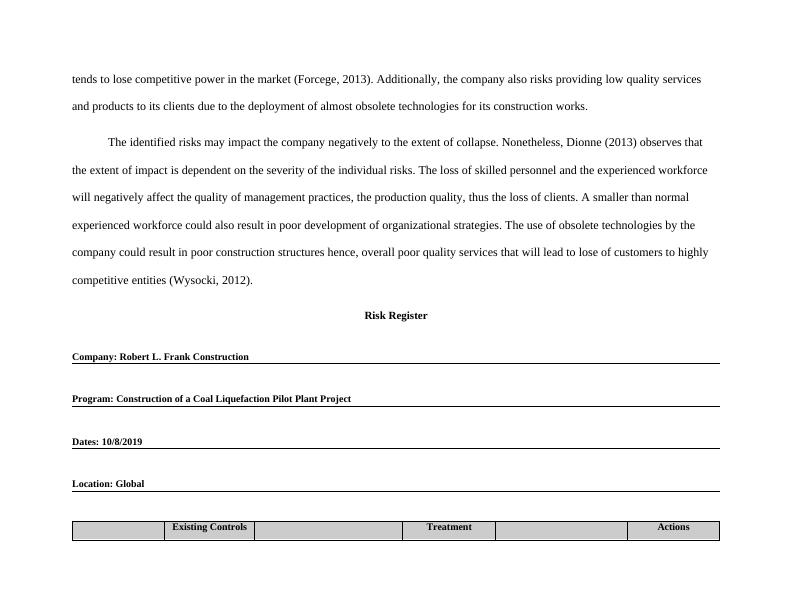Risk Management 2022 Assessment
Added on 2022-09-22
9 Pages1931 Words25 Views
Risk Management
Introduction
Risk management is an essential element for project managers since the tasks involved in projects tend to have some levels of
risks. According to Snyder (2012), a risk is an uncertain occurrence that may have either negative or positive effects on the predefined
objectives of a project. The possibility of a risk occurring in an organizational setting may affect performance of both employee and
managerial systems in the two ways; positively or negatively. While most project managers tend to focus on the negative effects of a
risk, there are also positive ones which may create room for opportunities for the project functions (Wysocki, 2012). Therefore, the
process of risk management comes in to assist the project managers and other stakeholders on the possibility and impacts of probable
risks, a risk register is developed and risks rated using the risk probability and impact matrix to identify, examine, and mitigate or
accept any uncertainties related to a particular project (Heldman, 2013). In this assessment, a risk register is given and then an
intensive assessment on the risks and their impacts on Robert L. Frank Company based on its operating status. Also, the risk
management report is given to demonstrate how the various stakeholders can either eliminate minimize, or accept the existing and
possible risks.
Overview
The construction company, Robert L. Frank handles both construction and engineering works in the production of chemicals,
petrochemical, petroleum, pharmaceutical, and mining. The company has headquarters in Canada and the United States and has been
Introduction
Risk management is an essential element for project managers since the tasks involved in projects tend to have some levels of
risks. According to Snyder (2012), a risk is an uncertain occurrence that may have either negative or positive effects on the predefined
objectives of a project. The possibility of a risk occurring in an organizational setting may affect performance of both employee and
managerial systems in the two ways; positively or negatively. While most project managers tend to focus on the negative effects of a
risk, there are also positive ones which may create room for opportunities for the project functions (Wysocki, 2012). Therefore, the
process of risk management comes in to assist the project managers and other stakeholders on the possibility and impacts of probable
risks, a risk register is developed and risks rated using the risk probability and impact matrix to identify, examine, and mitigate or
accept any uncertainties related to a particular project (Heldman, 2013). In this assessment, a risk register is given and then an
intensive assessment on the risks and their impacts on Robert L. Frank Company based on its operating status. Also, the risk
management report is given to demonstrate how the various stakeholders can either eliminate minimize, or accept the existing and
possible risks.
Overview
The construction company, Robert L. Frank handles both construction and engineering works in the production of chemicals,
petrochemical, petroleum, pharmaceutical, and mining. The company has headquarters in Canada and the United States and has been

in existence for approximately 40 years. Before attaining a net worth of over $1 billion, the company had won many tenders in its line
of production. The organizational structure of the company is perhaps its most significant strength considering the nature of operations
it undertakes. Nevertheless, Robert L. Frank Company has a declining backlog that has seen its value drop to around $600 million by
the year 1998. Therefore, to cut on recurrent expenditure, the management sort to reduce the size of human resource yet this was the
most important element in the winning of tenders and contracts. While the company has been awarded a contract to construct a coal
liquefaction plant, a number of risks are inherent.
Risk Identification and Impact Assessment
The management of risks occurs in the event that the project manager quantifies the probable losses of a project function, thus
device mechanisms to counter the effects or take advantage in the event that the risks pose desirable opportunities. The risks at the
company can be categorized as operational, human resource, marketing, and managerial. The company has been laying off its
workforce due to the fall of profits which made the sustenance of a large human resource pool virtually impossible. Apparently, some
of the employees laid off have vast skills and experience that the company should not risk losing in the event that contracts increase in
the future. Such skilled employees may easily be lost to the competitors hence the market situation proving difficult for the case
organization (Heldman, 2013). Having invested heavily in the recruitment and training of staff, laying them off at an early stage could
result in long-run costs as the company may not have recovered the invested costs. Recently, the company has not been winning
contracts and tenders, this could be attributed to the poor marketing strategies. A company that does not evolve its marketing strategies
of production. The organizational structure of the company is perhaps its most significant strength considering the nature of operations
it undertakes. Nevertheless, Robert L. Frank Company has a declining backlog that has seen its value drop to around $600 million by
the year 1998. Therefore, to cut on recurrent expenditure, the management sort to reduce the size of human resource yet this was the
most important element in the winning of tenders and contracts. While the company has been awarded a contract to construct a coal
liquefaction plant, a number of risks are inherent.
Risk Identification and Impact Assessment
The management of risks occurs in the event that the project manager quantifies the probable losses of a project function, thus
device mechanisms to counter the effects or take advantage in the event that the risks pose desirable opportunities. The risks at the
company can be categorized as operational, human resource, marketing, and managerial. The company has been laying off its
workforce due to the fall of profits which made the sustenance of a large human resource pool virtually impossible. Apparently, some
of the employees laid off have vast skills and experience that the company should not risk losing in the event that contracts increase in
the future. Such skilled employees may easily be lost to the competitors hence the market situation proving difficult for the case
organization (Heldman, 2013). Having invested heavily in the recruitment and training of staff, laying them off at an early stage could
result in long-run costs as the company may not have recovered the invested costs. Recently, the company has not been winning
contracts and tenders, this could be attributed to the poor marketing strategies. A company that does not evolve its marketing strategies

tends to lose competitive power in the market (Forcege, 2013). Additionally, the company also risks providing low quality services
and products to its clients due to the deployment of almost obsolete technologies for its construction works.
The identified risks may impact the company negatively to the extent of collapse. Nonetheless, Dionne (2013) observes that
the extent of impact is dependent on the severity of the individual risks. The loss of skilled personnel and the experienced workforce
will negatively affect the quality of management practices, the production quality, thus the loss of clients. A smaller than normal
experienced workforce could also result in poor development of organizational strategies. The use of obsolete technologies by the
company could result in poor construction structures hence, overall poor quality services that will lead to lose of customers to highly
competitive entities (Wysocki, 2012).
Risk Register
Company: Robert L. Frank Construction
Program: Construction of a Coal Liquefaction Pilot Plant Project
Dates: 10/8/2019
Location: Global
Existing Controls Treatment Actions
and products to its clients due to the deployment of almost obsolete technologies for its construction works.
The identified risks may impact the company negatively to the extent of collapse. Nonetheless, Dionne (2013) observes that
the extent of impact is dependent on the severity of the individual risks. The loss of skilled personnel and the experienced workforce
will negatively affect the quality of management practices, the production quality, thus the loss of clients. A smaller than normal
experienced workforce could also result in poor development of organizational strategies. The use of obsolete technologies by the
company could result in poor construction structures hence, overall poor quality services that will lead to lose of customers to highly
competitive entities (Wysocki, 2012).
Risk Register
Company: Robert L. Frank Construction
Program: Construction of a Coal Liquefaction Pilot Plant Project
Dates: 10/8/2019
Location: Global
Existing Controls Treatment Actions

End of preview
Want to access all the pages? Upload your documents or become a member.
Related Documents
Case Study on the Risk Management 2022lg...
|13
|2534
|19
Risk Management: A Case Study of Robert L. Frank Construction Companylg...
|12
|1912
|341
Project Execution and Control - Risk Identification and Managementlg...
|8
|1323
|499
Change Control: Robert L. Frank Construction Companylg...
|7
|1452
|353
Case Study Analysis of R.L. Frank Construction Companylg...
|10
|1881
|317
Risk Management Report 2022lg...
|16
|2384
|23